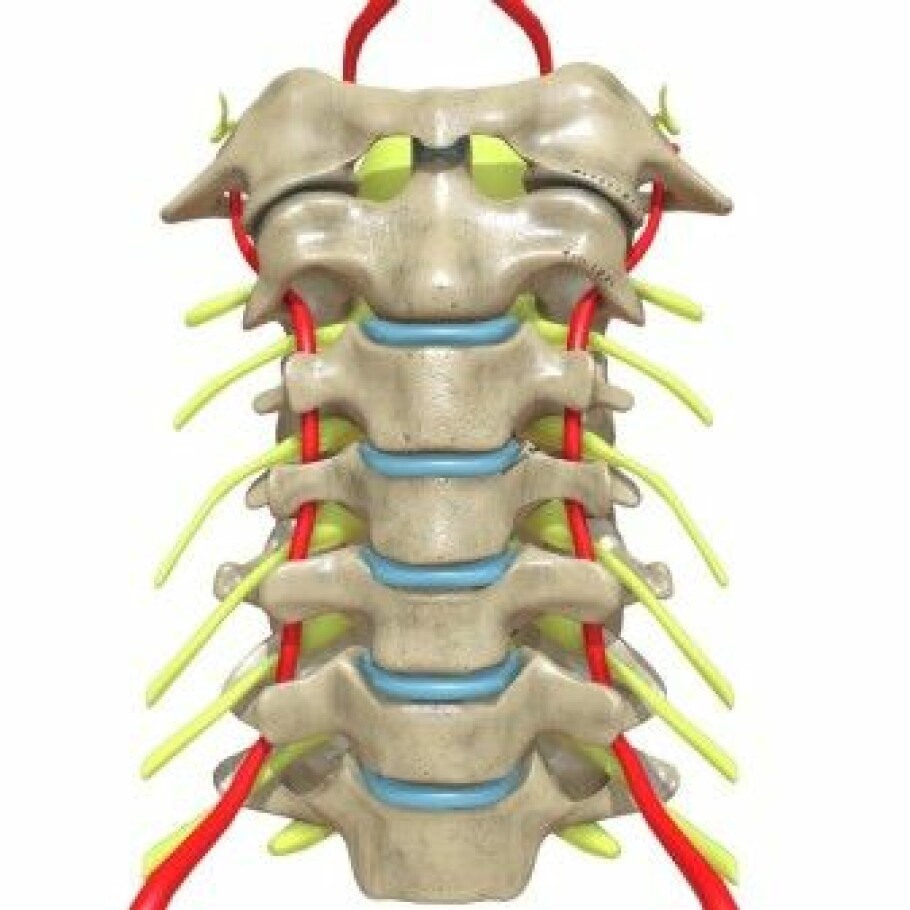
Is it dangerous to crack your neck?
ASK A RESEARCHER: Some love to do it, others shudder at the thought. But can cracking your neck be harmful?
After a long day spent concentrating in front of a computer screen, you may find it tempting to lean your head to the side and crack your neck.
Or are you the one who gets annoyed at the constant neck cracking noises your co-worker makes in the office?
But can cracking your neck be dangerous?
We have talked to three experts – a chiropractor, a manual therapist and a neurobiologist – to find out if cracking one’s neck is dangerous, harmless or healthy.
Two glass plates and a frying pan
The neck is complex stuff. In humans, it consists of seven vertebrae – bones stacked on top of each other – that continue down the spine before the spinal column ends at the buttocks.
Several blood vessels run along the cervical spine, carrying blood to the brain. Within the spine is your nervous system, which relays all the signals to and from the brain that control your body.
Given how vital the neck is, it’s no wonder some people worry about crackly noises in their neck.
What you’re hearing, though, is probably – and fortunately – not the sound of vertebrae scraping against each other, but rather the same kind of sound you hear when you crack your knuckles.

This sound comes from the joints, which tie the bones together. You can imagine a joint as being like two glass plates lying on top of each other. Between these glass plates – or the joint surfaces – lies a small layer of joint fluid, which allows the plates to slide neatly over each other.
Volume
The popping sound you hear when you crack fingers, toes and other joints is the joints being pulled apart. The volume increases in the space between the joints, creating a void. This causes the gas that is dissolved in the joint fluid to be drawn out and converted into a small gas bubble.
This little gas pocket collapses again, creating a pop! The negative pressure is similar to when you struggle to lift a wet frying pan from the kitchen counter.
As a rule, it takes between 10 and 30 minutes for the pressure to build up again before the joint can be re-cracked.
"The creaky sounds in the neck are probably happening in the small side joints on either side of the vertebrae," says Per Brodal, a neurobiologist and professor of medicine.
“Sometimes you may hear similar sounds coming from tendons slipping over each other, but that's more common in the ankles.”
The danger of stroke

A quick search for “cracking neck” on the internet results in a number of news articles with scary examples, including:
A twenty-four-year-old paramedic who was partially paralysed after a severe crack as she stretched her neck, or the twenty-eight-year-old man from Oklahoma who tore a blood vessel to the brain and lost all sensation in half his body after he stretched his sore neck. NBC2 has posted a video in which a professor explains why neck cracking can be so dangerous.
Stroke, blood clots and tears in important blood vessels are just some of the words that appear in an online search on the topic.
All three experts that ScienceNorway has talked to are familiar with the stroke issue.
Tim Raven is a chiropractor who is currently working on his doctorate focusing on the neck. He says that several major studies have investigated the link between professional neck cracking and stroke.
It is important to note that the studies concern professionals, like chiropractors, and not “hobby neck crackers.” Manipulation is the professional term used for the flexing and stretching of joints.
Must be a weakness
“First of all, it's important to know that this type of stroke that’s often mentioned is extremely rare,” says Raven.
He explains that one of the most definitive studies on this is from Canada. There researchers looked at a certain type of stroke cases, and whether the patient had been to a chiropractor or their GP before the event.
“It turns out the risk of stroke isn’t any greater with a chiropractor than with a GP. Since chiropractors often manipulate the neck, and doctors don’t, the conclusion was that the association between stroke and neck cracking was random.
Raven says that no studies have been done that look at whether self-spinal manipulation is linked to stroke .
“Research shows that strain on the blood vessels from manipulation isn’t sufficient to damage the vessel wall. There has to be a pre-existing weakness, which is rare and can be triggered entirely by normal neck movements like washing your hair,” he says.
“There is no research that I know of that supports the claim that regular neck cracking, done by yourself or for treatment purposes, increases the chance of this type of stroke that is, quite simply, rare and random,” Raven says.

Patients need to be checked
Gro Camilla Riis, a manual therapist at the Norwegian Sports Medicine Institute (NIMI) and associate professor at OsloMet, also highlights studies done on the relationship between (professional) manipulation and stroke by Norwegian authorities and researchers in Australia.
"This has nothing to do with the manipulation. Patients who come in often report having a pain in their head – and a headache is a marker for a beginning stroke", she says.
As a professional therapist, Riis says she has to ask a lot of questions about the patient's health history before she can decide whether or not it is safe to recommend a treatment.
To the reporter’s question of safety “when I lean my head to one side and it cracks, and then I lean my head to the other side and it cracks?”
Riis says, “This is absolutely harmless.”
Eggshell veins
Neurobiologist Brodal says that discussion has arisen about possible adverse effects and criticism of chiropractors when it comes to manipulating the neck.
In rare cases, serious side effects have been reported, so he believes it is important for such treatment to be carried out by experienced clinicians who can assess what is safe for the individual patient.
He also says that as you get older, the veins that run close to the neck vertebrae can become stiff and eggshell-like. He says it is likely, but not proven, that strong movements of the neck can cause these blood vessels to close and cause a stroke. Therefore, he believes one should be extra cautious in manipulating the neck in the elderly.
“Some people with arthritis have a weakness in the upper neck joints because the ligaments have weakened. But I'm sure neither chiropractors nor manual therapists use neck manipulation in such cases,” he says.
“Anyway, neck manipulation is something that should be done by professionals. Untrained people shouldn’t go around cracking each other or twisting and turning their necks."
Is it dangerous?
“A lot of people stretch their neck until it cracks because it feels good afterwards. This movement is basically not unhealthy,” says Raven.

"But if they have to do it repeatedly to achieve the good feeling, this probably isn’t the solution for what’s bothering them. Then they should get help in finding a better solution,” he says.
He says he doesn’t know of any research suggesting that cracking one’s neck oneself causes the neck to become weaker or causes lasting damage.
Raven does cite research showing that finger cracking is associated with reduced grip strength and slight swelling around the joint, but says that this finding cannot simply be transferred to the neck joints without a separate study.
“It’s a good idea to have a strong and supple neck so that you don’t need to crack it. That’s where exercise comes in,” he says.
Neurobiologist Brodal says the popping sound just tells us that the joint has temporarily expanded, and this is neither good nor bad as such.
“But if the point is to force the neck joints into an extreme position, then I can’t see what good that would do,” he says. He doesn’t recommend stretching the neck repeatedly if it doesn’t crack at first.
Inflammatory response
Brodal also says that cracking the neck is not harmful in itself, as long as you control it yourself, but that you can risk an inflammatory response if you do it often.
“And then it hurts. So I have a hard time seeing it as beneficial,” he says.
“It’s different when a trained chiropractor treats people with muscle tension. We know that can benefit a lot of people.”
The neurobiologist says he thinks doing a little neck stretching and cracking, for example at the computer screen at work, is not very dangerous as long as you don’t force the neck too roughly.
“Because when you do it yourself, you stop when it gets too uncomfortable. So if you're not too extreme in doing it, then I wouldn't think it's dangerous,” he says.
“And if a person feels that this self-treatment helps a lot, then by all means.”
Chiropractor weighs in
“It would take a lot for people to injure themselves by cracking their own neck. The human body has an inherent self-protective property that inhibits violent movements,” says Raven.
“In the worst case, you could strain a muscle, a joint capsule or ligaments. These injuries go away by themselves after a short time, or may require some treatment to help with recovery.
He says that our neck structure has evolved to protect the spinal cord and nerves from injury. He also says this structure allows for many forms of movement, such as looking over our shoulder or looking under the sink.
“It doesn’t make sense to think that the neck is so fragile that it can’t withstand the “normal” movements that we all do.
He defines everything that is within the body's physiological limits as normal movements, although the movements are occasionally more or less abrupt.
He also adds that you can damage everything if you’re too rough.
Is it a good idea?
“If a person thinks neck cracking feels good, then that’s a health benefit in itself. Maybe it helps a person relax more and exercise better than if their neck was stiff. As I said before, people do this because it feels good,” says Raven.
“They don’t want to hurt themselves, and so harm is unlikely. It’s not at all common that patients come in with “self-manipulation” as the cause for injuries or neck pain."
Raven says he doesn’t encourage anyone to crack their neck themselves, but that we shouldn’t scare people who are already doing it. He also says you shouldn’t be afraid to do normal movements.
But if it feels good, can't that be good in itself?
Neurobiologist Brodal does not rule out that the placebo effect may play a role for people who crack their own neck, as with any other treatment. The placebo effect is a term for a phenomenon where you may feel better, because you think something works.
“The expectation that you have heard this helps may lead you to do it. Anyway, if you feel better from it, then it's good,” he says.
An article on Healthline also mentions that neck cracking can release endorphins in the neck joint. This drug is the body's own pain reliever and, in many ways, works like morphine. The release of this substance may explain the good feeling many people get by cracking their neck.
The article also notes that all stretching must be done carefully, and not too often.
Joint fluid
“We think the reason why it feels so good is because the joint fluid increases after neck cracking. It kind of lubricates the joint, so it feels more mobile,” says manual therapist Riis.
She also says that in professional treatments, cracking can send a wave of signals to the brain. This stimulus can distract the nervous system and relax your muscles for a little while.
"You can call it a health benefit in the sense that you feel less discomfort," she says.
Riis believes all exercise can provide health benefits and that all physiological movements are completely unproblematic for the body.
“I don't have the evidence to say that cracking one’s neck is healthy, but we can't say it's unhealthy either,” she says.
Disagreement
Brodal, the neurobiologist, does not discount that this wave of signals to the nervous system can temporarily relax the muscles.
“It may help to reset a system. Just like when you turn your computer off and on when it gets hung up,” he says.
On the other hand, he is sceptical about cracking leading to more joint fluid, or that cracking should be seen as a good thing in the first place. He says nothing indicates that it is lubricating the joint.
Brodal finds it hard to believe that the joint fluid would increase that much. “I don't think there's any research that shows that,” he says.
He says there is no point in increasing the joint fluid, because all that’s needed is a thin layer, just enough to lubricate the joint surfaces. “Increased joint fluid is usually a sign of joint inflammation.”
“What can happen if you push and crack and bend the joints into extreme positions all the time, is that you get an inflammatory reaction. And then you might get more joint fluid, but that’s a result of something that isn’t desirable at all,” says Brodal.
Manual therapist Riis responds that increased joint fluid and circulation is a natural response to physiological movements in real body joints, and that inflammation is a completely different condition.
Does the method make a difference?
Some people who crack their necks swear by doing one side at a time, while others like to roll their heads around and do everything at the same time. Does the choice of method make a difference?
“The neck is an incredibly complex structure that allows movements in many directions. If the chosen movement feels right, it probably isn’t a problem to do it,” says Raven.
Riis says there is a difference between using the neck's own muscles versus using one’s arms to assist the movement.
To summarize
Chiropractor Raven emphasizes that you should not let untrained people try to crack your neck.
He says if a person cracks their own neck and thinks it does some good occasionally, then they can keep doing it. If someone has to do it often in order for their neck to feel good, that would indicate that something else should be done that gives a better long-term result.
Manual therapist Riis says that, absent symptoms suggestive of serious illness, stretching and bending your head slightly in front of your work monitor is no problem if you are feeling tension.
On the issue of whether or not to use your hands for help, she says that increasing your stretch a little by using your hands is okay if you feel it does you good.
Neurobiologist Brodal says it's mostly about using common sense.
“If you sit around cracking your neck all the time, it's probably not good, but if you do it once in a while then it’s certainly harmless,” he says.
———
Read the Norwegian version of this article at forskning.no






























